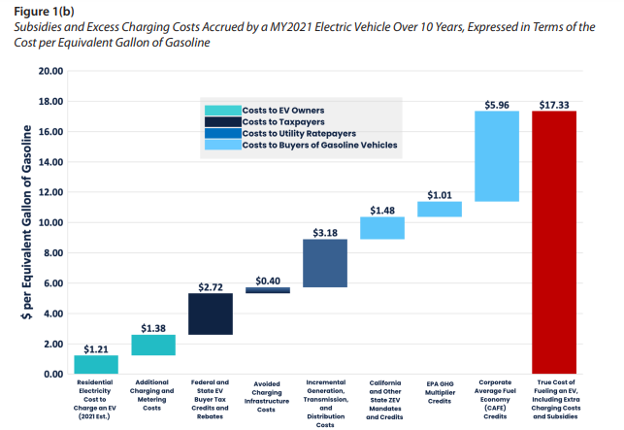YOU SHOULD SUBSCRIBE TO CLIMATE CHANGE WEEKLY.
IN THIS ISSUE:
- Electric Vehicles Are Much More Costly than Commonly Claimed
- Podcast of the Week: Debunking Persistent Myths About Hydraulic Fracturing
- Ninety-Nine Percent Consensus? Not so, Says New Analysis
- Papers Point to Urban Heat Islands for 2023’s Hot Summer Temperatures
- Video of the Week: COPs and Robbers – Follow the Money
- Climate Comedy
- Recommended Sites
Miss Anything at Heartland’s Climate Conference? No Problem.

Electric Vehicles Are Much More Costly than Commonly Claimed

Electric Vehicles (EV) have been much in the headlines recently, from stories detailing the difficulties with charging them, to losses suffered by major auto makers pushing them at the behest of the Biden administration, to EV fires, the dependence on China for critical components used in EVs including their batteries, range and function issues, and beyond.
I have discussed the myriad problems with EVs on multiple occasions in recent months. For instance, I addressed range concerns in detail in a Liberty & Ecology article. And I examined problems with EV fires and resulting insurance problems in CCWs 486, 481, and 427, among other posts.
Recent surveys show that more important than their limited range and hauling capacity, their tendency to fail in bad weather and spontaneously combust, or any other issue, the upfront price of an EV is the factor driving automobile and truck consumers’ decisions concerning whether to purchase an electric vehicle. Car buyers enter the market knowing EVs, even with generous taxpayer-funded tax credits, carry an up-front price premium. But it turns out the higher up-front costs are only part of the story. In fact, a new study from the Texas Public Policy Foundation (TPPF) indicates EVs are even more expensive—much more expensive—to drivers, taxpayers, and the economy as a whole than anyone previously calculated, much less publicized.
“Major selling points promoted by EV advocates are lower maintenance and fueling costs over the life of the vehicle and the common claim reductions in battery prices will eventually make EVs less expensive to own than ICEVs [internal combustion engine vehicles],” writes the TPPF. “For example, a study conducted by a group at the Argonne National Laboratory estimated that while an average EV is about $22,000 more expensive to purchase than a comparable ICEV, they cost about $14,000 less to fuel, insure, and maintain over a 15-year period, making their lifetime cost only $8,047 more than an ICEV. …”
The authors of the TPPF study express skepticism concerning whether the Argonne lab’s cost estimates are accurate or optimistic, based on favorable economics driven by the Biden administration’s EV promotion efforts. Those concerns aside, TPPF points out, “no one has attempted to calculate the full financial benefit [or cost] of the wide array of direct subsidies, regulatory credits, and subsidized infrastructure that contribute to the economic viability of EVs.”
The TPPF’s research indicates an “average model year (MY) 2021 EV would cost $48,698 more to own over a 10-year period without $22 billion in government favors given to EV manufacturers and owners.” And when the subsidies for the EV charging network are considered, the costs of EVs are even higher.
Among the hidden or unaccounted for costs TPPF details vis-à-vis EVs are:
- Direct state and federal subsidies for EVs average $8,984 per vehicle over 10 years.
- Home and public charging stations used by EVs put a significant strain on the electric grid, resulting in an average of $11,833 in socialized costs per EV over 10 years, which are shouldered by utility ratepayers and taxpayers.
- Regulatory credits with bonus EV multipliers from federal fuel efficiency and greenhouse gas emissions standards and state EV sales mandates provide an average of $27,881 in benefits per vehicle for producers of EVs.
Concerning the last cost item—typically unaccounted for when discussing the subsidies for EVs—auto manufacturers get Corporate Average Fuel Economy credits they can resell on the market for every EV sold that are seven times higher than the actual fuel savings the vehicles provide. In 2021, Tesla would not have reported a profit except for the sale of those credits (totaling more than $1.78 billion in 2022). Automakers Ford, GM, and others already cross-subsidize the cost of their EVs, to keep the prices down, by boosting the price of the ICEVs they sell. It turns out they also add much of the cost of the fuel economy regulatory credits sold to them by Tesla and others to the sticker price for ICEVs. The fact they are losing tens of thousands of dollars on each EV sold indicates that even with the cross-subsidies they can’t recoup the full costs of the vehicles and the regulatory credits they must purchase for each popular, relatively low mileage, ICEV they sale.
The bottom line, per the TPPF, is:
EV advocates claim that the cost of electricity for EV owners is equal to $1.21 per gallon of gasoline…, but the cost of charging equipment and charging losses, averaged out over 10 years and 120,000 miles, is $1.38 per gallon equivalent on top of that. Adding the costs of the subsidies to the true cost of fueling an EV would equate to an EV owner paying $17.33 per gallon of gasoline.

But, of course, these true fueling costs aren’t borne by the EV owner alone. They are spread across all taxpayers. Since the vast majority of EVs are purchased by those in the highest income and tax brackets, it means the poor and middle class are providing welfare for wealthy people’s EV fetish. Now that’s a regressive tax policy!
And that’s just the costs the TPPF study calculated. The TPPF notes “these estimates do not include the hundreds of billions more in subsidies in the Inflation Reduction Act (2022) for various aspects of the EV supply chain, particularly for battery manufacturing.”
Other hidden or unaccounted for costs related to federal and state efforts to rapidly expand the adoption of EVs include, but are not limited to:
- Billions of dollars in taxpayer-funded subsidies for electric buses, trucks, and truck stops, plus the addition of charging infrastructure at public facilities such as ports and airports;
- Billions in state and city taxpayer-funded subsidies other than state buyer credits, such as credits from California’s low-carbon fuel standard, which is a cross-subsidy from gasoline buyers to EVs;
- The unaccounted cost of EVs in terms of additional emissions from power plants, and the embedded environmental costs of the EV supply chain.
- The cost of allowing EVs to use managed lanes, such as high-occupancy vehicle lanes, and the cost of parking spaces given to EVs and EV charging stations.
- The [opportunity] cost to consumers of additional time spent charging EVs relative to fueling gasoline/diesel vehicles.
- Disproportionately high road damage from heavier EVs compared to gasoline/diesel vehicles.
- Disproportionately high EV recall costs compared to gasoline/diesel vehicles, which are socialized to buyers of gasoline and diesel vehicles from the company initiating the recall.
Discussing the study’s findings, Jason Isaac, a former Texas state legislator and the study’s co-author, told The Center Square, “The real cost of a Ford Lightning is closer to $172,00 and no one would buy them at that. I know their sales have tanked. The [electric] Silverado sold 18 electric trucks last quarter.”
In the end, the indirect subsidies and costs related to EVs—costs unaccounted for in normal calculations—dwarf the $15,000 to $20,000 premium auto manufacturers charge for each EV they sell, paid for directly by the vehicles’ purchasers. Everyone is paying dearly for climate scolds’ increasingly successful efforts to get ever more EVs on the road, premised upon displacing ICEVs in order to reduce the transportation sector’s greenhouse gas emissions.
Get your Copy at Amazon TODAY!

Podcast of the Week
Heartland Institute Research Fellow for Environment and Energy Policy Linnea Lueken was a guest on the Ron Arquette Show on KRNS radio in Salt Lake City, Utah. She was invited on to talk about a new paper she wrote with Heartland’s Tim Benson titled “Debunking Four Persistent Myths About Hydraulic Fracturing.” As Linnea explains, “fracking,” as it’s commonly called, is the process of extracting natural gas and oil from several miles deep beneath the surface of the Earth.
Subscribe to the Environment & Climate News podcast on Apple Podcasts, iHeart, Spotify or wherever you get your podcasts. And be sure to leave a positive review!
Ninety-Nine Percent Consensus? Not so, Says New Analysis

A new study published in the journal Climate by a group of researchers from various universities and research institutes in Israel (Dentelski, et al.) debunks a study in another journal that claimed support for the theory humans are causing dangerous climate change “anthropogenic global warming” (AGW) tops 99 percent.
A 2021 study (Lynas et al.) claimed a review of a random sample of 3,000 publications discussing climate change, out of “a dataset of 88125 climate-related papers published since 2012,” found fewer than one percent, four or 28 depending upon the methodology used to identify the papers, disputed that humans were causing climate change.
Ignoring the fact consensus is a political exercise to establish strong agreement on a goal, not a scientific method to establish facts or truth, numerous scholars have refuted previous claims of a purported 97 percent consensus “established” using similar methodologies—examining abstracts and then subjectively categorizing them into consensus or skeptical. Indeed, international surveys of scientists working in climate-related fields have repeatedly shown that no such consensus exists.
The new Dentelski et al. study examining the methodology and conclusions of the Lynas et al. paper claiming a 99 percent consensus supporting the AGU theory finds the methodology used in the 2-21 paper is flawed and biased, and its conclusion unjustified.
Describing why it is important to carefully analyze any assertion that an irrefutable AGU consensus exists, the Israeli scholars write:
The extent of the consensus among scientists on the anthropogenic origin of modern global warming has become a key issue in the “anthropogenic global warming” … While a consensus alone clearly does not serve as scientific proof or substantiate a specific scientific hypothesis, it is nonetheless influential in bolstering the reception of a particular thesis within the broader public sphere. This influence is amplified by the inherent trust that society places in scientists, who provide informed opinions grounded in empirical evidence. … The well-defined scientific hypothesis that “humans, through the emission of CO2, are responsible for most of the recent (since the mid-20th century) changes in global average temperature” (dubbed the AGW hypothesis hereafter) is typically linked with various, somewhat less quantifiable, statements, such as that humanity is facing an imminent climate crisis, and are followed by calls for action on individual, community, country, and global levels.
The Climate paper points out that the 2021 paper was flawed from the outset because its authors failed to precisely define the AGU hypothesis they claimed represented a consensus.
“By blurring the hypothesis, Lynas et al. leave room for a subjective decision on supporting some version of the hypothesis,” write Dentelski et al. “[Yet because] consensus, in the context of the climate discussion, can mean different things and has different dimensions … within each dimension, the specific consensus statement must be as specific, and quantitative, as possible.”
Starting from an ill-defined, vague notion of the AGU hypothesis being tested for consensus, Lynas et al.’s paper then examined the abstracts of 3,000 climate-change-related papers out of more than 88,000 published since 2012, sorting them into categories: (1) explicit quantitative support of the AGW hypothesis, (2) explicit non-quantitative support, (3) implicit support, (4) no position or uncertainty, (5) an implicit rejection of the AGW hypothesis, (6) explicit rejection without quantification, and (7) an explicit quantitative rejection.
It turns out that by their own standards, more than two-thirds of the papers they analyzed either took no position or there was uncertainty about their position. So, what did Lynas and his colleagues do? After tossing 282 papers as not being climate related, after all, they counted the remaining neutral and uncertain papers as accepting the AGU hypothesis. Voila, you have a 99 percent consensus.
As Dentelski and his colleagues point out, one could just as easily have counted the neutral/uncertain category papers as skeptical and, as a result, concluded that just 32 percent of the published research supported the AGU hypothesis, however defined.
Adding insult to injury (to the scientific method and logic), Dentelski et al. found a number of papers categorized as neutral were actually disputing or proposing alternative explanations for measured and modeled warming, like papers from Soon et al. In the end, the new paper in Climate shows that absent a clearer definition of AGU to be tested for consensus and a more accurate methodology in treating papers, there is no justification for the claim there is a 99 percent (or 97 percent) consensus humans are causing dangerous climate change in the published literature.
Source: Climate
Heartland’s Must-read Climate Sites



Papers Point to Urban Heat Islands for 2023’s Hot Summer Temperatures

Writing in American Thinker, Mark Adams notes that although 2023’s summer was hotter than normal, as the mainstream media voluminously report, three recent papers published in respected peer-reviewed journals have concluded that much of the hyped heat was a result of the Urban Heat Island (UHI) effect, with compromised ground-based temperature stations in expanding urban and suburban areas biasing the local and thus global averaged temperatures upward.
As Adams writes:
Although urban areas occupy only about 4% of the land surface, most weather monitoring stations are located in urban regions. Those same regions … have an abundance of concrete and asphalt, both of which have remarkable heat-absorbing properties. The result is that these urban islands are warmer than their rural counterparts. That raises an important question: If the majority of temperature readings are taken in areas of inherently higher temperature how much does this skew the claimed rise in temperatures?
If the three peer-reviewed papers published recently are right, it turns out a lot of the “record setting” extended heat this summer was likely due to UHIs.
Those three papers, published in the journals Climate, the Journal of Research in Astronomy and Astrophysics, and the Journal of Applied Meteorology and Climatology, after examining copious amounts of data, conclude that as much as 40 percent of the reported temperature increase this summer was attributable to the UHI effect.
These papers, of course, are not the only studies implicating UHIs in the recent reported rise in temperatures that so alarms the U.N. Intergovernmental Panel on Climate Change and the mainstream media.
Most recently, Climate Change Weekly 485 discussed research from scientists at the Earth System Science Center at The University of Alabama in Huntsville which indicates summer warming since 1885 has been exaggerated by as much as 100 percent. And my colleague, meteorologist Anthony Watts, recently updated earlier research confirming the vast majority of surface temperatures stations (96 percent of those surveyed, in fact) used by the National Oceanic and Atmospheric Administration (NOAA) to record and report temperatures in the United States, are corrupted by the UHI effect, failing to meet NOAA’s own standards for trustworthy temperature data.
In short, mounting amounts of research confirm what climate realists like myself and the rest of us at The Heartland Institute have long said: Reported surface station temperatures are badly compromised and shouldn’t be used to raise alarm about a supposed unnatural increase in temperatures, the rate of rising temperatures, or anthropogenic climate change more generally. Alarm is unwarranted based on real world data.
Source: American Thinker
Video of the Week
This week on “Climate Change Roundtable,” our trio of host Anthony Watts and panelists Linnea Lueken and H. Sterling Burnett turn their attention to the COP28 Climate Conference set to commence in Dubai on November 30th. To shed further insight into the conference is Craig Rucker from CFACT, who is set to attend COP28. Rucker will share his expectations of the conference, highlight the special interests at play, and predict how the event will unfold.
Tune in every Friday at 1 p.m. ET to watch the Climate Change Roundtable LIVE on The Heartland Institute’s YouTube Channel, and also on Rumble.



























